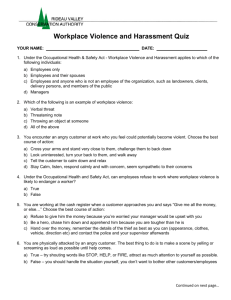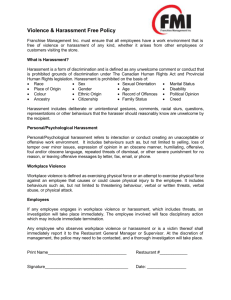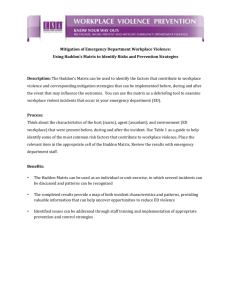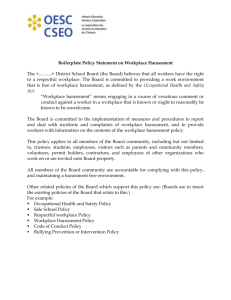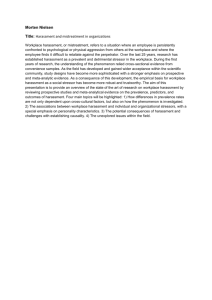Workplace Violence and Harassment Policy
advertisement
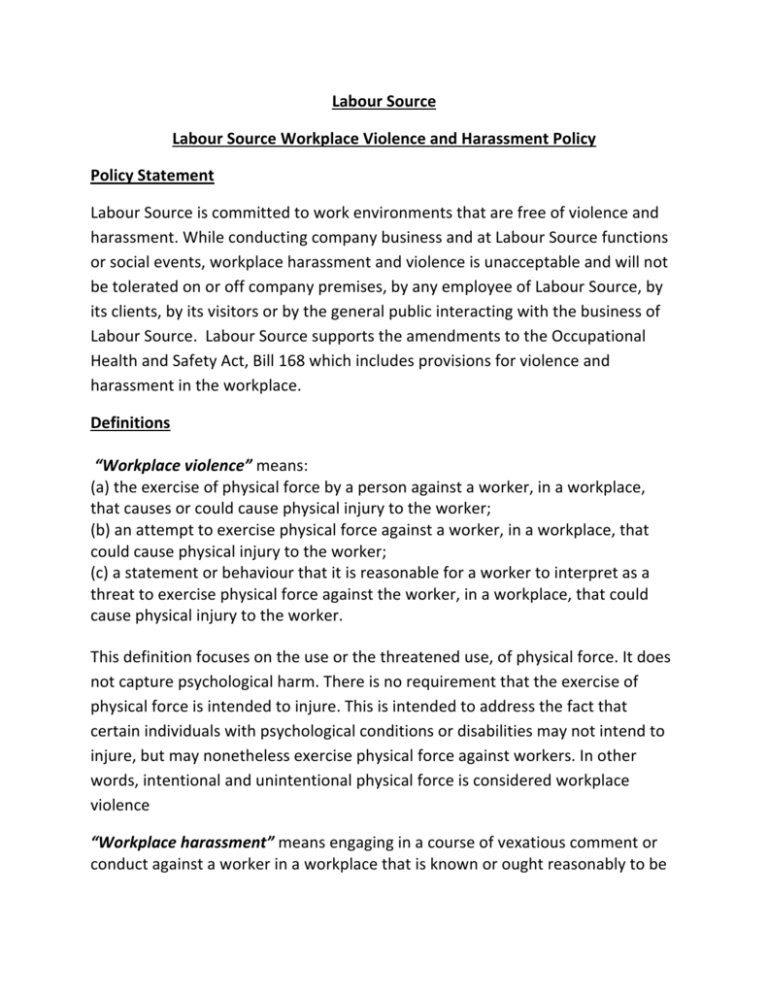
Labour Source Labour Source Workplace Violence and Harassment Policy Policy Statement Labour Source is committed to work environments that are free of violence and harassment. While conducting company business and at Labour Source functions or social events, workplace harassment and violence is unacceptable and will not be tolerated on or off company premises, by any employee of Labour Source, by its clients, by its visitors or by the general public interacting with the business of Labour Source. Labour Source supports the amendments to the Occupational Health and Safety Act, Bill 168 which includes provisions for violence and harassment in the workplace. Definitions “Workplace violence” means: (a) the exercise of physical force by a person against a worker, in a workplace, that causes or could cause physical injury to the worker; (b) an attempt to exercise physical force against a worker, in a workplace, that could cause physical injury to the worker; (c) a statement or behaviour that it is reasonable for a worker to interpret as a threat to exercise physical force against the worker, in a workplace, that could cause physical injury to the worker. This definition focuses on the use or the threatened use, of physical force. It does not capture psychological harm. There is no requirement that the exercise of physical force is intended to injure. This is intended to address the fact that certain individuals with psychological conditions or disabilities may not intend to injure, but may nonetheless exercise physical force against workers. In other words, intentional and unintentional physical force is considered workplace violence “Workplace harassment” means engaging in a course of vexatious comment or conduct against a worker in a workplace that is known or ought reasonably to be known to be unwelcome. Harassment may include racial, ethnic, sexual, bullying and psychological intimidation. Responsibilities Labour Source Labour Source will establish a Workplace Violence and Harassment Policy and enact a related program within its organization to protect its workers. In situations, where Labour Source worker are assigned to work on at a client company, Labour Source will be sure its client adheres to the legislated expectations related to Workplace Violence and Harassment per Bill 168 of the Occupational Health and Safety Act. Client Managers Client managers will establish a Workplace Violence and Harassment Policy and enact a related program within its organization to protect its workers. The manager will enforce these policies in their work settings per the legislated expectations related to Workplace Violence and Harassment per Bill 168 of the Occupational Health and Safety Act. Client Supervisors Client supervisors will adhere to the established Workplace Violence and Harassment Policies and Procedures in their work settings. This includes taking the lead in maintaining safety in the work setting, initiating investigations when incidents of workplace violence or harassment occur, and involving the appropriate authorities and personnel within their company and at Labour Source. Workers Workers will behave in a way that maintains a workplace free of violence and harassment. If an incident of violence or harassment occurs, the victims and witnesses must report the incident immediately to their direct supervisor and the authorities if necessary. Labour Source Workplace Violence and Harassment Program Labour Source supports the prevention of workplace violence and harassment and is committed to assisting its employees and client companies in all aspects of prevention and investigation of such incidents. It is Labour Source’s business practice to ensure that its employees work in environments on Labour Source premises and at client companies that comply with the expectations of Ontario Bill 168 – a recent amendment of the Ontario Health and Safety Act. Labour Source’s Workplace Violence and Harassment program includes: 1. Policy Statement 2. Procedure to control risks and prevent violence in the workplace. 3. Procedures for summoning assistance in the event of actual or potential workplace violence and harassment 4. Procedure for reporting complaints or actual violence or harassment in the workplace 5. Procedure for investigating complaints or actual violence or harassment in the workplace. Risk of violence in the work place Violence and harassment can happen anywhere – at home, in the community or at work. For the sake of personal wellbeing, people need to recognize when and where they are at increased risk of violence or harassment and try to minimize risk. There are certain workplaces and work situations where risk of workplace violence is increased. These include some of the following: employees who handle cash, work nights, deal directly with the public or are involved in the sale of alcohol. Workplaces such as retail businesses, especially late at night, health care, corrections, law enforcement, social services, education, financial services, taxi services and public transit are some other examples of situations where there is increased violence and harassment. Notification of risks: In an effort to protect its employees from risk of violence and harassment, Labour Source will endeavor to identify and communicate workplace violence risks for its employees. As most Labour Source employees work of client company premises, it can be expected that client supervisors will be take on the key role of notifying Labour Source employees of risks. When Labour Source becomes aware of a risk of violence or harassment at a workplace, it or the client company will inform its employees as soon as possible. This communications may take place in one of several ways: direct verbal discussion with Labour Source office staff or client supervisor, telephone call from Labour Source office staff or client supervisor, or communication via email, letter, or paycheck note and communication bulletin boards at worksite. Labour Source will select the communication method that it deems most effective in advising its employees of potential or actual risks. Individuals with history of violence: On occasion, employers hire or become aware of individuals with history of violence. If a Labour Source employee will be exposed to such an individual, Labour Source is committed to inform or have its client companies inform its employees of the identity and/or pertinent personal details of such an individual. It must be understand that such information will be provided on a “need to know” basis as the personal rights of all individuals must be considered. Domestic violence in the workplace: There are situations that violence from an employee’s home or community setting becomes a risk at the workplace. Domestic violence can include physical violence, sexual violence, and stalking and criminal harassment. Bill 168 requires that “If an employer becomes aware, or ought reasonably to be aware, of domestic violence that would likely expose a worker to physical injury may occur in the workplace, the employer shall take every precaution reasonable in the circumstances for the protection of the worker.” If Labour Source becomes aware of a domestic violence situation that may put its employees at risk at the workplace, it will do what is required including informing the client company, setting up administrative controls, or involve the appropriate authorities as required to protect its employees. Minimizing risk in the work place: In its daily business activities, Labour Source managers and employees will be constantly mindful of preventing and minimizing risks in the workplace. Due to the nature of Labour Source’s business, the majority of Labour Source employees work at client company work sites. Because of this situation, Labour Source employees are subject to the policies and procedures of the client companies where they are assigned. Though Labour Source is not in a position to develop its client companies’ policies and procedures, we are committed to working with companies that are mindful of the legislated safety expectations in Ontario and other districts where our employees work. (see Appendix B) The following outlines some of the accepted methods that Labour Source supports for itself and its client companies to minimize risks from violence and harassment in the workplace: • Administrative controls such as enacting policies that minimize workplace violence and harassment including policies on working alone, appropriate work schedules, guidelines dealing with threatening workplace behavior and access to police and emergency services • Engineering controls that modify the work environment to optimize safety and prevent risks such as lighting, panic buttons, access to exits, security at facility entrances, bullet proof glass, restrict access to the workplace or area including physical barriers, plastic shields, card-­‐only access, locked doors, etc. • Personal Protective Equipment use promotes safety including steel toed boots, gloves, phones, personal alarms, plastic shields etc. Reporting Workplace Violence or Harassment Workplace safety is the responsibility of both employers and employees. Labour Source employees are strongly encouraged to report incidences of actual or potential workplace violence or harassment to their direct supervisor and/or Labour Source supervisor as soon as possible. Employees are assured that there is no risk or discrimination or retaliation against employees because they may be a victim of potential or actual workplace violence or harassment. How should a victim get help if harassed or exposed to violence at work? 1. If unable to diffuse the situation alone, a victim of violence or harassment should leave the perpetrator of violence or harassment as soon as possible and go to a safe place. Waiting to get away may only allow the situation to get worse. It is important that the employee become oriented to the work site they are assigned to so they can identify safe areas and areas that are isolated or may have increased risk. 2. The victim should contact their workplace/client supervisor immediately then when possible the Labour Source office to report the incident. 3. In many situations, it might be necessary to contact the police. If ongoing personal risk exists, call 911 immediately. 4. The employee and employer should determine if it is necessary to seek medical attention after such an incident. Right to Refuse Work With the exception to employees whose accept jobs which includes a certain degree of accepted risk such as firefighters, police officers, paramedics, health care workers, Labour Source acknowledges the right of employees to refuse work that is unsafe or a risk of violence. The employee is asked to be available for investigation of the incident. This right only exists in situation of violence but in not available for harassment. How does a victim or witness report an incident of violence or harassment? 1. It is the responsibility of the victim of harassment or violence and witnesses to report it to his or her immediate supervisor at the assigned workplace. The supervisor must then follow up with the appropriate personnel within the company such as human resources, or senior management so the incident is thoroughly investigated. 2. If a Labour Source employee is involved in such an incident at a client company, Labour Source should be contacted at 905-­‐264-­‐9675. Labour Source will offer support to the employee or client company representative to assure that the Labour Source employee is protected from further incident and the situation is investigated. Investigating Complaints of Violence or Harassment Labour Source administration is committed to facilitating and supporting the actions its staff, supervisors and client supervisory staff to stop and prevent workplace violence and harassment. Once risk to safety is minimized, a workplace manager should initiate an investigation of the incident(s) and identify methods to deal with the incident and prevent reoccurrence. This investigation will be directed by the client company because it is on its work site. An investigation may include interviews with victim, perpetrator, and other employees. Police may be involved if criminal activity is suspected. Medical follow-­‐up should be encouraged if any physical injury is suspected. Labour Source will assist with investigation at client companies if possible. Pertinent documentation related to such an incident including incident report completion and copies of all correspondence related to the incident will be included in the employee file of all Labour Source employees involved. Labour Source will also report any investigations related to workplace violence or harassment to its health and safety committee. Things to consider in situations involving violence and harassment When incidents of violence or harassment in the workplace occur, the individuals involved in resolving the incident must behave in a way that minimizes injury and stops and prevents reoccurrence of such incidents in the future. These types of incidents can provoke many emotions in the individuals involved including the victims, perpetrators, and work site personnel. Such feelings may include fear, sadness, anger, anxiety, apathy, depression, and confusion. It is most important to recognize these emotions may exist and they are a natural human reaction in these situations. Victims of harassment or violence, individuals assisting victims and those perpetrating violence or harassment must recognize the difference between the feelings toward such incidents and the workplace policies and the actions required to stop and prevent further violence or harassment at the workplace. It is important that the person responsible for managing such incidents remain calm and diligently follow the investigation procedure so that risk can be minimized and further incidents prevented. Labour Source supervisors will be available for consultation to employees and clients when such incidents occur. As a part of Labour Source commitment to keep workers safe, all efforts will be made to remove all risks of violence and harassment through education, linking to resources, support and if necessary employment at another location. Privacy during investigation of incidents During the enactment of all aspects of this policy, Labour Source will adhere to personal privacy issues as per the Labour Source Privacy policy and PIPEDA standards. Disclosure of personal information will occur as necessary to investigate or discipline related to harassment and violent incidents or where required by law. Infringement of Policy Any Labour Source employee that attempts to interfere with or impedes the Labour Source’s Policy for Workplace violence or harassment will be subject to disciplinary measures and including termination of employment. Training Program regarding Workplace Violence and Harassment Labour Source will make available as a part of its Workplace Violence and Harassment program to employers, supervisors and employees, information regarding how to minimize risk from violence and harassment and what to do if such incidents occur. Basic training on the workplace violence policy, how to report an incident or how to summon assistance will be provided to workers. The following are some of the methods of training provided to Labour Source employees: • written information will be provided to employees upon hire in the Labour Source employee handbook • on occasion during employment with Labour Source via newsletters and paycheck, information supplements will be provided reinforcing the details of the Labour Source Workplace Violence and Harassment Policies • referral to online resources and community supports as necessary. Client companies will also be provided with the details of this Labour Source policy and program. As required, Labour Source will also refer its clients to related resources and information regarding the expectation in Bill 168. Resources Ontario Ministry of Labour www.labour.gov.on.ca -­‐ Ministry of Labour’s Guideline Workplace Violence and Harassment: Understanding the Law http://www.labour.gov.on.ca/english/hs/pubs/wpvh/index.php -­‐ A Toolbox http://www.labour.gov.on.ca/english/hs/pdf/wvps_toolbox.pdf (Includes Suggested Risk Assessment Template) Canadian Centre for Occupational Health and Safety http://www.ccohs.ca Ontario Safety Association for Community and Healthcare http://www.hchsa.on.ca -­‐ Domestic Violence Doesn’t Stop When Your Worker Arrives at Work: What Employers Need to Know to Help -­‐ http://www.hchsa.on.ca/products/free_resource.shtml Hick and Morley Human Resource Law and Advocacy -­‐Preventing Workplace Violence and Bill 168 – A Guide for Employers www.hickmorley.com Carswell Document Bill 168 http://www.hicksmorley.com/images/pdf/2010/FTRNow_Bill_168_05182010.pdf Review of Policy Labour Source is committed to reviewing this policy annually to keep it current with the laws of the land and changes in Labour Source business. Appendix A will be used as a guideline to direct the annual policy review. Appendix A Reviewed previous incidents for the last year including first aid, security and critical injury reports to determine if workplace violence occurred? If so, consider the following: What was the frequency of violence? What area or job classification was affected by an incident(s)? Did a worker suffer a critical injury or fatality or lost time from work? Who committed the violent incident? Customer? Co-­‐worker? Spouse? Were steps taken to prevent further incidents? What steps can be taken to prevent or reduce the risk of a similar incident? Are all workers able to summon immediate assistance if a workplace violence incident occurs? What risks have similar employers identified? What risks are commonly associated with the type/conditions of work (i.e. robberies? aggressive patient/student behaviour?) Do workers have a mobile workplace (i.e. enter other workplaces or private homes)? What precautions has the other employer taken to protect these workers if an incident occurs? Do your employees have the ability to summon assistance if necessary? Once you have identified areas of risks, consider the likelihood of a violent incident occurring (low, medium, high) and the severity of an injury if an incident did occur (first aid, lost work time of less than 5 days, critical injury, fatality) Consider what controls should be put in place to reduce or eliminate the risk of workplace violence (especially high risk situations where it is highly likely there could be a serious physical injury to a worker). Appendix B Violence and Harassment Risk Assessment Checklist for Client Company Sites Does the company have a workplace violence policy? Does the company have a workplace violence prevention program (or parts of one)? Does the company program set out how to and to whom to report incidents of workplace? Does the program detail an investigation procedure? Does the program set out the duties and responsibilities of supervisors, managers and workers? Does the workplace violence program consider: working/travelling alone procedure; emergency / lock down procedure, aggressive behaviour training, security measures including panic buttons, security alarms, restricted access floors, etc. Has the physical workplace been surveyed (including parking lots, windows, doors, areas where medication/drugs/cash stored, meeting rooms, isolated areas, etc. for lighting, safety risks, proper functioning locking devices)?
